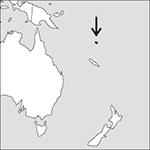
Source: MAPS IN MINUTES™ © RH Publications (1997)
Capital:
Port Vila
Area:
12,189 sq km (4,706 sq miles)
Population:
261,565 (2013 est)
Religions:
Presbyterian 27.9%; Anglican 15.1%; Seventh Day Adventist 12.5%; Roman Catholic 12.4%
Ethnic Groups:
Ni-Vanuatu 97.6%
Languages:
Bislama, French, English (all official); local languages
International Organizations:
UN; Commonwealth; Pacific Islands Forum; Secretariat of the Pacific Community; Non-Aligned Movement; WTO
A country comprising a double chain of over 80 south-west Pacific Ocean islands between latitudes 13° and 21°S and longitudes 167° and 170°E.
Physical
Only a dozen of Vanuatu’s islands are suitable for settlement, the largest being Espíritu Santo, Efate, Malekula, Maewo, Pentecost, Ambrim, Erromanga, and Tanna. Of volcanic origin, they are very hilly. South-east trade winds moderate the heat from May to October.
Economy
Small-scale agriculture employs about two-thirds of the workforce and provides Vanuatu’s principal exports: copra, beef, cocoa, timber, kava, and coffee. Fishing, financial services, and tourism are also important.
History
During the 19th century, thousands of the indigenous people of Vanuatu—Kanakas—were taken to work on sugar plantations in Queensland, Australia. The population was decimated and took many years to recover. The islands were placed under an Anglo-French naval commission in 1887. In World War II they served as a major Allied base. They became an independent republic and member of the Commonwealth of Nations in 1980. In 2015 Cyclone Pat devastated Vanuatu, leaving over 65,000 people homeless and destroying much of the islands’ agriculture.
- etiolation
- ETR
- Etruscans
- Ettinghausen effect
- ETX/ACK
- E-type asteroid
- eu-
- Eubacteria
- Eubilides
- eucarpic
- Eucaryota
- eucaryote
- euchromatin
- Euclid
- Euclid (300)
- Euclid (300 bc)
- Euclid (330?–275? bc)
- Euclidean Algorithm
- Euclidean construction
- Euclidean distance
- Euclidean domain
- Euclidean geometry
- Euclidean group
- Euclidean norm
- Euclidean space